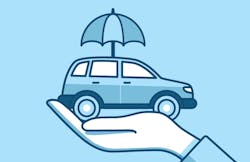According to the Q4 2016 Industry Trends Report put out by Mitchell International, 93 percent of millennials would buy usage-based insurance. Willis Towers Watson, an insurance brokerage and advisory company, anticipated that by the end of 2016, 17 million people will have tried it. The pay-as-you-go insurance model has been around for years, so why is it on the rise now—particularly with millennials—and how will it impact the collision repair industry?
Robin Harbage, a director with Willis Towers Watson, has worked with usage-based insurance in some form for 20 years. Prior to his current position at Willis Towers Watson, Harbage was involved in creating the foundation for Progressive Insurance’s Snapshot device, which offers a discount to users with safe driving habits. Harbage shares his insight on the rise of usage-based insurance and whether the anticipated decline of accidents in the future will impact collision repair shops.
What exactly is usage-based insurance and why would a driver be interested in this type of model?
The concept is literally just taking the information that comes out of a vehicle—telematics—and using that information to judge the operation of that vehicle based on safe practices. The insurer can then take that information and rate how safely the vehicle is being operated and charge the driver based on that score.
For the consumer, there are a number of benefits. Clearly, if you’re a good driver, you can get a discount. The other is that if you’re exhibiting driving habits that are less than, shall we say, safe, then the driver can get feedback on how to improve driving. Someone may not realize bad habits but the behavior is pretty obvious when you actually look at the pattern of information. When we’re gathering data on drivers, we collect the GPS, latitude, longitude, heading and speed so we can actually pinpoint on what road they’re driving. We know the speed that they’re driving and what the speed limit is. People can learn a lot about their driving habits through this.
“People have the ability to show that they're good drivers and provide that information.”
—Robin Harbage, Director, Willis Towers Watson
Why is this type of insurance so popular among millennials?
We’re finding more and more now that telematics companies are popping up that will put information on a phone and collect that data. Smartphones are pretty ubiquitous amongst millennials; I think it’s something like 90 percent have them. This generation is always downloading apps. They’re very comfortable with this type of technology. This is a logical extension of what they’re already doing. In their minds, they’re thinking, “If I give you a little information, I could get a discount on my insurance. That works.”
Another factor is, whether or not they realize it, the demographics of driving are shifting tremendously with that age group. Whether it’s conscious or unconscious, they can save a lot of money on insurance because they’re driving differently than other generations. Millennials use a lot of ride sharing apps. They’re moving into urban areas and although these are busier areas where they’re more likely to get into an accident, they’re using public transportation more. In general, millennials are using vehicles less and this is a great way to demonstrate that to their insurers and get a discount.
In your opinion, will a rise in usage-based insurance lead to fewer collisions?
If I were a betting man, I’d say yes. There are three things going on right now that are driving accident frequency, one of them being usage-based insurance. People have the ability to show that they’re good drivers and provide that information. If they’re not a great driver, they now have an incentive to become better. I think that will have a significant impact over time. Another factor that will reduce accidents is what I mentioned before about millennials’ driving habits. There will be fewer cars on the road and over time that will reduce congestion. Third is all of the automated driving features, such as adaptive cruise control. These are making cars safer.
Obviously, fewer collisions are ideal, but what about shop owners that make a living in the collision repair industry?
I’m old enough to remember when airbags were first introduced. When they first came out, insurers had no idea if they would increase safety. Some of the insurers offered a 5 percent discount based on the idea that they most likely would be better. What they found was, yes, they do save lives. What we saw was that airbags reduced bodily injuries, losses in vehicles and there were fewer deaths. Getting back to collision repairers, this safety feature actually drove loss costs up. Why? Because every time a front-end collision occurs, the shop has to replace a $2,000 airbag.
What’s interesting about things like adaptive cruise control and other electronic safety features that usage-based insurance encourages is that yes, they will reduce accident frequency, but they will increase the expense of the repair. The actual cost to bring the vehicle back to its pre-damaged condition is going to be more. Collision shop managers are going to have to start recognizing this and making sure his or her shop is equipped to replace and repair these new technologies. This trend will change the skillset required, but will not eliminate the need for collision repairers.

